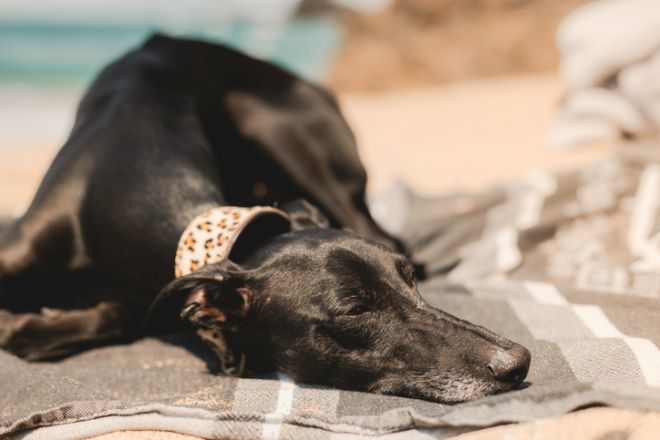Here’s How To Protect Your Pup From Sunburn
Don’t Let The Sun Scorch Your Pup — Protect Them Like A Pro

Humans aren’t the only ones who can suffer from sunburn—our beloved dogs are also at risk from the sun’s intense rays. Without proper protection, sunburn in dogs can lead to serious health issues that may require emergency care.
While a dog’s fur offers some natural defense against harmful UV rays, all breeds are vulnerable. According to Time, dogs with light-colored or thin coats face a higher risk, particularly short-haired breeds like pit bulls, Dalmatians, boxers, greyhounds, and pugs. Hairless breeds, such as the American hairless terrier and the Chinese crested dog, are even more susceptible to sunburn.
RELATED CONTENT: 7 Black-Owned Pet Brands To Shop On National Pet Day
During an interview with Time writer Angela Haupt published June 23, Veronica Villanueva, a medical director at VEG ER for Pets in Anaheim Hills revealed that vet clinics “see an uptick” in sunburn cases typically during the hot summer months as most pet owners aren’t aware of the “severity” and “potential risks” that can occur when sunburn strikes our furry friends.
Where does sunburn occur the most on dogs?
According to Nationwide and Pet Health Zone, certain areas on a dog’s body are more prone to sunburn, especially spots with little or no fur. These include the bridge of the nose, the belly and groin (often exposed when dogs lie on their backs to sunbathe, Time noted ), the area around the lips, the tip of the tail, and, depending on the breed, the eyelids and the skin surrounding the mouth. Villanueva said that the most common sunburn indicator that she typically sees is around the tip of the ears.
“Those can get burned really badly because the ears don’t get good blood flow, they don’t have much hair, and it’s a thin piece of skin,” the vet specialist explained.

The first and most noticeable sign of sunburn in dogs is redness on the skin, which is often tender to the touch. As the burn progresses, the affected area may become dry and flaky, and your dog may start scratching or chewing at it due to itchiness. In more serious cases, the skin may appear dark red, blistered, or even ooze pus—all signs that warrant immediate veterinary attention. Other symptoms of dog sunburn can include dry, cracked, or curled edges of the ears, hair loss, skin ulcers, and infections. In extreme or repeated cases, sunburn can lead to skin cancer, such as malignant melanoma, which often appears as abnormal tumors.
What are the best treatment options?
When treating a severe sunburn, veterinarians typically begin by assessing the area and providing pain relief. If there’s pus, the wound must be thoroughly cleaned and disinfected. Topical ointments may be applied to reduce inflammation, and in some cases, dogs require IV antibiotics. Sunburn can also cause or worsen dehydration, which is a serious health concern. If a dog is visibly dehydrated, they may need to be hospitalized and given IV fluids and electrolytes to stabilize their condition.
Prevention is key. Since the FDA does not currently regulate sunscreens for pets, it’s essential to speak with your veterinarian about using a pet-safe option. Never apply human sunscreen without professional guidance. Ingredients like zinc oxide, though effective for people, are toxic to dogs and can cause life-threatening anemia if ingested. Spray sunscreens should also be avoided, as they can irritate your dog’s eyes or be inhaled, leading to respiratory or internal issues. Look for sunscreens formulated specifically for pets that are free from zinc oxide and low in salicylates, and always consult your vet or a veterinary poison control service like the Pet Poison Helpline before use, according to Nationwide and Pet Health Zone.

Another effective way to protect your dog from harmful UV rays is with UV- or UPF-protective clothing, which can help shield the most vulnerable parts of the body. However, even with protective gear, areas like the ears, nose, tail, belly, and inner legs still need extra attention. When spending time outdoors, especially during peak sun hours, consider setting up a shaded area using a tent, beach umbrella, or E-Z Up canopy, whether you’re at the park, the beach, or in your own backyard. In the event of mild sunburn, apply a damp cloth to the affected area, and rub pure aloe vera on the region. It could ease sunburn symptoms for your precious pooch, Villanueva added.
If you suspect your dog has a serious case of sunburn, it’s always best to contact your veterinarian promptly. Early intervention can prevent complications and help your dog recover more comfortably and safely.
Let’s help our best friends stay away from harmful UV rays and have more fun this summer.
RELATED CONTENT: How To Keep Pets Home Alone Safe







